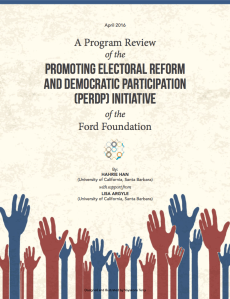A Review of the Promoting Electoral Reform and Democratic Participation Initiative
The challenge
Democratic participation must ideally make a significant difference in society (be powerful), be available to citizens (be possible), and be appealing to citizens (be probable). However, participation in the United States is, at best, only conditionally powerful, possible, and probable. Most evidence shows that systemic reform efforts aimed at lowering barriers to voting, while necessary, have had limited impact on increasing overall turnout rates. At the root of declining participation is the feeling among citizens that their participation does not matter. And many— especially people of color or low-income people— have negative experiences of the role of government in their lives. Moreover, while civic associations are key to helping citizens develop agency and mobilize their participation, there is a growing imbalance between organizations that represent business or the wealthy and those that represent the middle class, working class, or poor.
What we did
In 2016, the Ford Foundation sought a systematic review of its Promoting Electoral Reform and Democratic Participation (PERDP) initiative. PERDP is a part of Ford’s Civil Engagement and Government (CEG) thematic area, which seeks to improve lives and lessen inequality using government and political process. The aim of the review was to understand whether the initiative had a clear theory of change that matched broader understandings of what worked in strengthening civic engagement and democracy. The study’s key questions were: When is participation powerful? Does participation matter? How do we make participation possible and probable?
For this analysis, Hahrie Han and Lisa Argyle of the University of California, Santa Barbara, reviewed data including PERDP grant proposals and reports from 2013-14, academic literature, and interviews with grantees, funders, Ford staff, academics, and other practitioners.
What we learned:
“Data show that people’s sense of whether they have any say over government or whether public officials care about them has been declining since the mid-twentieth century.”
The report provides core recommendations for how to make participation not only powerful, but also possible and probable for ordinary people.
Key among these recommendations are:
- To make participation powerful, invest in organizations that can link authentic grassroots power with elite lobbying relationships, and that have strategic capacities. Analysis of successful change efforts finds that having elite lobbying relationships is more predictive of winning than having more lobbying money, campaign money, membership, or other resources. Research also shows that the organizations and coalitions best positioned to develop those relationships are those that can consistently demonstrate the ability to move a constituency. Organizations with strategic capacity can more effectively navigate uncertainty and a rapidly changing socio-political environment.
- To make participation possible, couple systematic reform— to make it easier for people to vote and otherwise participate— with efforts to make participation probable. Research finds that the effect of any one systemic reform (litigation, election law, election administration, election protection, census, and redistricting work) is greatest when coupled with coordinated mobilization efforts.
- To make participation probable, build infrastructure that can enable transformative, relational experiences. A wide array of research has demonstrated that dynamic social interactions and identities shape people’s decisions to take civic and political action. Membership-based civic organizations have the potential to create transformative social interactions that shape the decision to act, and the development of political identities over time.
- While seeking “profits” in the immediate-term (such as electoral wins, policy gains, and other tangible victories) democratic organizations also need to achieve those gains in ways that build their assets going forward. Are votes gained, elections won, and policies passed in ways that build the strategic capacity of organizational leaders, that strengthen the relationship between the organization and its constituency, and that translate those relationships into elite lobbying power?
- Policies with “organizing hooks” built into them have created durable and scaled change. The nature and design of a policy can launch feedback loops that create incentives for organizations to organize constituencies with an interest in protecting that policy over the longer-term.
- Developing the power to influence change requires attention at the local, state, and national levels. While organizations are more likely to concentrate their resources at the national level, building national power often depends on having a robust infrastructure at the state and local level. The challenge is to act at each level in a way that has positive feedback loops for other levels.
